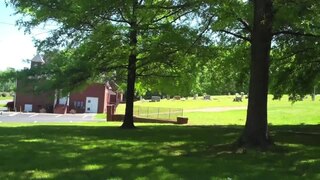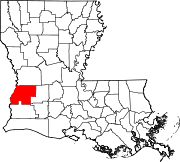
Vernon Parish is a parish located in the U.S. state of Louisiana. As of the 2020 census, the population was 48,750. The parish seat is Leesville. Bordered on the west by the Sabine River, the parish was founded in 1871 during the Reconstruction era.

Beauregard Parish is a parish located in the U.S. state of Louisiana. As of the 2020 census, the population was 36,549. The parish seat is DeRidder. The parish was formed on January 1, 1913.

DeRidder is a city in, and the parish seat of, Beauregard Parish, Louisiana, United States. A small portion of the city extends into Vernon Parish. As of the 2010 census DeRidder had a population of 10,578. It is the smaller principal city of the Fort Polk South-DeRidder CSA, a Combined Statistical Area that includes the Fort Polk South and DeRidder micropolitan areas, which had a combined population of 87,988 at the 2010 census.
Plaquemine High School is a public high school located at 59595 Belleview Drive in unincorporated Iberville Parish, Louisiana, United States, south of the City of Plaquemine. It serves grades from seven to twelve and is administered by the Iberville Parish School Board.

The Rosenwald School project built more than 5,000 schools, shops, and teacher homes in the United States primarily for the education of African-American children in the South during the early 20th century. The project was the product of the partnership of Julius Rosenwald, a Jewish-American clothier who became part-owner and president of Sears, Roebuck and Company and the African-American leader, educator, and philanthropist Booker T. Washington, who was president of the Tuskegee Institute.

Dunbar Gifted & Talented Education International Studies Magnet Middle School is a magnet middle school for students in grades 6 through 8 located in Little Rock, Arkansas, United States. Dunbar Magnet Middle School is administered by the Little Rock School District. It is named for the nationally known African-American poet, Paul Laurence Dunbar.

The Alexandria Museum of Art (AMoA) of Alexandria, central Louisiana, United States opened its doors in 1977 in downtown Alexandria in the historic Rapides Bank and Trust Company Building. Rapides Bank and Trust Company Building is a historic bank building completed in 1898 in the Renaissance Revival style, and was added to the National Register of Historic Places on May 15, 1980. In 1998, AMoA expanded and constructed its grand foyer and offices as an annex to the Rapides Bank Building. In 1999, AMoA was honored as an Outstanding Arts Organization in the Louisiana Governor's Arts Awards. In 2007, the Museum entered into a collaborative endeavor agreement with Louisiana State University of Alexandria (LSUA). AMoA now also serves as a downtown campus for LSUA classes and is host to multidisciplinary community events, including concerts and recitals, lectures, yoga classes, Second Saturday Markets, and Museum Afterhours. These events support all art forms – film, literature and poetry, songwriting and visual arts.

The Avery Coonley School (ACS), commonly called Avery Coonley, is an independent, coeducational day school serving academically gifted students in preschool through eighth grade (approximately ages 3 to 14), and is located in Downers Grove, DuPage County, Illinois. The school was founded in 1906 to promote the progressive educational theories developed by John Dewey and other turn-of-the-20th-century philosophers, and was a nationally recognized model for progressive education well into the 1940s. From 1943 to 1965, Avery Coonley was part of the National College of Education (now National Louis University), serving as a living laboratory for teacher training and educational research. In the 1960s, ACS became a regional research center and a leadership hub for independent schools, and began to focus on the education of the gifted.

A. C. Steere Elementary School, formerly Broadmoor School, is an elementary school located at 4009 Youree Drive in Shreveport, Louisiana, and operated under the direction of the Caddo Parish school board.
Henry Clay Yerger was an American schoolteacher who pioneered African-American education at Hope, Arkansas.
Beauregard Parish School Board is a school district headquartered in DeRidder in Beauregard Parish in southwestern Louisiana, United States.
Peabody Magnet High School is a public magnet high school located in the South Alexandria subdivision of Alexandria, Louisiana in the United States. Alexandria is the seat of Rapides Parish and the largest city in central Louisiana. The school is named for one of its benefactors, George Foster Peabody (1852–1938), whose charitable foundation provided a grant to create the school. It was founded in 1895 as a segregated black of school and was formerly known as Peabody High School, Peabody Training School, Peabody Industrial School, and Peabody Normal School.

Liberty Colored High School is a former high school for African-American students in Liberty, South Carolina during the period of racial segregation. It originally was called Liberty Colored Junior High School. The building is now a community center known as the Rosewood Center. It is at East Main Street and Rosewood Street in Liberty. The school was built in 1937 on the site of a Rosenwald school that had burned down.

The Davenport Community School District Is a public school district in Scott County, Iowa. The school district covers 109 square miles (280 km2) that includes the city of Davenport, where it is based, and the western Scott County communities of Blue Grass, Buffalo and Walcott in addition to a small section of Muscatine County. Founded in 1858 it established one of the first publicly funded high schools in the United States, the third teachers’ training school and hired the first female superintendent in the country. It serves nearly 16,000 students in 32 school buildings.

Douglass School in Lexington, Kentucky, US, was both a primary and secondary Fayette County Public Schools from 1929 to 1971. Douglass School operated solely for African American students. The building that once housed Douglass School, located at 465 Price Road, was listed on the National Register of Historic Places in Fayette County in 1998.

Greensville County Training School, also known as the Greensville County Learning Center, is a historic Rosenwald school building located at Emporia, Virginia. It was built in 1929, and is a single-story, U-shaped brick building. It consists of a front hyphen that connects two wings containing classrooms, while an auditorium, office space, and a library form the interior central space. A classroom addition was constructed in 1934. It was constructed for the education of African-American students, and closed in the 1960s following desegregation of the public schools.
The Arcadia Colored High School was a high school for African-American students in Arcadia, Louisiana, United States. It was originally known as Bienville Parish Training School and was later known as Crawford High School. It eventually was a campus of 10 buildings.
The Kirkwood R-7 School District is a public school district headquartered in Kirkwood, Missouri.

A two-room schoolhouse is a larger version of the one-room schoolhouse, with many of the same characteristics, providing the facility for primary and secondary education in a small community or rural area. While providing the same function as a contemporary primary school or secondary school building, a small multi-room school house is more similar to a one-room schoolhouse, both being architecturally very simple structures. While once very common in rural areas of many countries, one and two-room schools have largely been replaced although some are still operating. Having a second classroom allowed for two teachers to operate at the school, serving a larger number of schoolchildren and/or more grade levels. Architecturally, they could be slightly more complex, but were still usually very simple. In some areas, a two-room school indicated the village or town was more prosperous.

The Union Station School is a historic building and former segregated public school for African-American students from 1928 until 1966, located in Paducah, Kentucky. It has been listed on the National Register of Historic Places since August 19, 2011 for ethnic heritage.


















